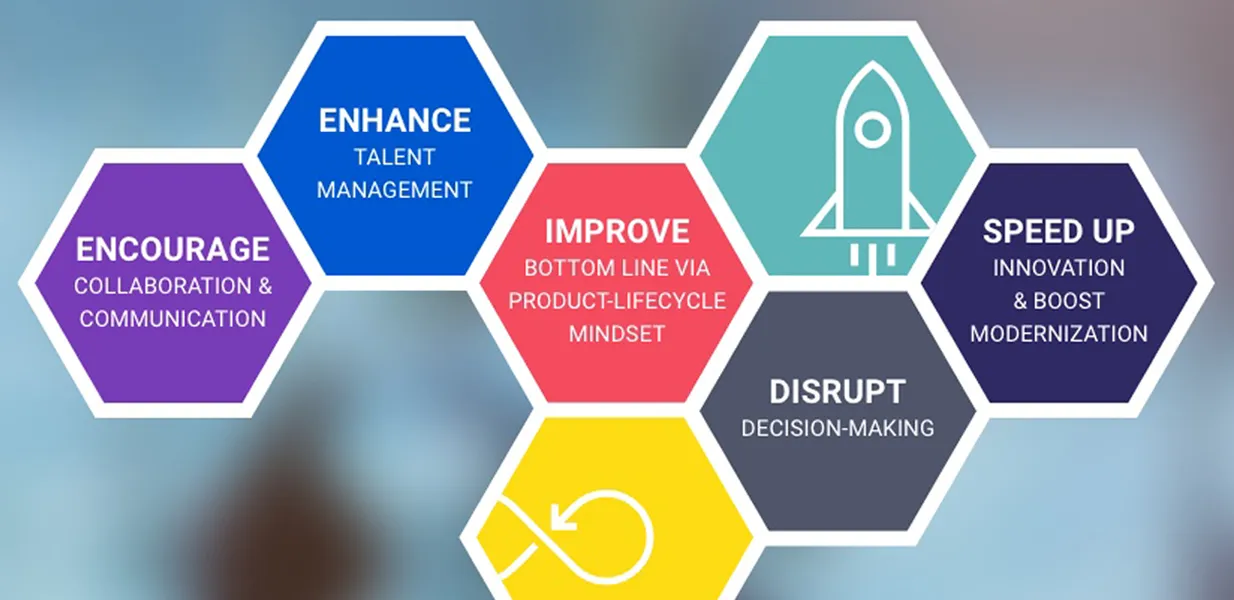
Organizational agility – how to achieve it beyond agile development
In the nearly two decades since the appearance of The Agile Manifesto, Agile Software Development proved it’s not a fad, winning out over traditional methodologies. Agile development has fully transformed how software is created: it makes us faster, but is this enough to make our products smarter, better, or more innovative?

To foster leaps in innovation and digital transformation, companies need to go the extra mile and adopt Agile methods that promote organizational agility rather than employing Agile solely in their software development processes. Organizational agility calls for a higher level of collaboration and communication between IT and business - embracing the methodology at all operational business levels. Thus enterprise-wide agility allows to spark innovation and help organizations spot, refine, and make new ideas into working market realities quickly.
What is organizational agility?
The concept of organizational agility is more straightforward than it sounds. It denotes the application of a straightforward idea - being agile - to the whole modus operandi of a business. This spans across all business operations from software development to marketing.
The Agile model enables companies to quickly optimize strategies and processes that are lagging. Adaptability to the constant state of flux in the business world increases, and this makes the organization more resilient and able to deliver to both its customers and employees.
It is crucial to differentiate organizational agility from “fake agile” - the act of merely applying agile for faster software development. It goes further than this, as it empowers companies to be quick and versatile in their responses to internal and external changes while staying in line with their vision and goals. As the software development process steadily shifts towards continuous delivery, agility allows businesses to also sustain a continuing conversation with the marketplace.
Another critical point of differentiation is that organizational agility is not simply about fixing productivity, even though that is a powerful effect that it brings. It does bring speed, flexibility, and increased employee engagement, which translates into a productivity boost. However, the actual value of agility lies in its ability to steer an organization towards a position of strength that transcends short-term gains.
How to ensure Agile’s power in your organization
Although the process of adopting organizational agility is complicated and depends on the specificities of your organization, there are tried-and-true steps that will steer your business on the agile path. Here are five points to consider while on the path of implementing Agile methods to your overall business operations:
1. Go beyond architectural rigidity
As tough as it may be for businesses to face this, legacy technology and architecture can dramatically hamper agility. They can slow down how an organization can develop new features and functionalities that the market demands.
In the process of identifying what to adopt and what to change, it is vital to find the right spots that would give the best results if provided with an extra investment. Using modern principles such as APIs and microservices has been proven to work, and changing legacy technology is an option, even though a difficult one.
It is also imperative to know how ready your organization is to take a huge step towards agility, such as cloud migration. You need to take into consideration a myriad of factors to get the timing right. Undergoing a cloud readiness assessment can help a lot in identifying constraining factors and enablers in the process.
2. Improve talent management
Smart hiring and management of talent is paramount to achieving organizational agility, requiring both IT experts and good managers with solid business perspective on the team, and choosing only one of the two leads to issues. If you opt for tech staff only, the connection with the overarching business priorities may fail. Alternatively, if you choose only business savvy experts, the technological part may suffer. While technologists who have a business perspective are difficult to scout, they are essential in the pursuit for enterprise agility and are a requirement for DevOps. They are becoming the metaphorical Rosetta Stone of turning your organization into a truly agile one.
The growing use of external agile talent has become one of the possible answers to that problem but only when used wisely. According to Accenture’s The Rise of the Extended Workforce, it’s not only the cost-saving consideration that is driving this trend. Advanced tech and cross-functional expertise is a significant factor for many companies to choose external consultants. Selecting a trusted and knowledgeable partner like Resolute Software can thus equip you with the right talent for your move to full agility.
3. Cultivate a product-lifecycle mindset
Another cornerstone for implementing agility across an organization is the mindset applied in product development. The old-school approach of the waterfall method, which is still prevalent in many businesses, is based on individual projects with fixed timeframes, instead of on a whole product. However, products have a completely different life and function in comparison with projects. Products link ongoing software development with specific business goals and results.
Becoming fully agile, thus, requires a shift towards a product-lifecycle mindset. It is based on the understanding that digital products do not exist in distinct time slots, but rather have continuous lifecycles. When an organization adopts that view, it can reshuffle software development processes to fit around this. In turn, this allows for better results and greater visibility - and all-round improved bottom line.
4. Distribute funding in a flexible way
The slow and challenging process of funding different segments of activity in an organization can be a major hurdle for overall agility. By the time that a business decides and enacts the decision to allocate money to a particular field, it may be too late which impacts the speed of innovating.
That’s why some experts have called on business managers to innovate the way they think of their different teams. The idea is to treat them as in-house startups or spinoffs, as they each constitute a team of experts who are on a quest to find a solution for a business problem.
This means that whenever a promising opportunity arises, an organization should be ready to adapt to the new situation and direct funding to have a shot at grasping it.
5. Disrupt the decision-making model
An important factor in the move towards organizational agility is the change that needs to be made in the decision-making processes of a company. The traditional way is focused on ensuring the ‘yes’ of numerous levels of management. While it offers a high degree of security in case of errors, it is burdensome and slow.
Agility requires a revamp in this area as well. Instead of sustaining the top-down model, organizations have to allow teams to operate as autonomously as possible. This entails that teams, functioning almost as separate spinoffs, should be able to set their priorities and handle their resources accordingly. They become largely self-organizing units within a connected network - a living and changing organism that the company constitutes.
Disrupting the old model of decision-making can be difficult for organizations, as it can be seen as a challenge to the stability of traditional hierarchy. Nonetheless, it’s worth the effort as it provides the necessary flexibility and adaptability for full-blown enterprise agility to be achieved. Thus the whole organization operates as an interactive network - led and managed in innovative ways.
Ready for an external boost to your agility?
While the process of moving to organizational agility is labor-intensive, there are trusted partners who can help you out on the way. Leveraging third-party IT consulting can significantly contribute to your digital transformation by providing you with the necessary tech and cross-functional expertise.
Interested in giving it a try? Get in touch with us to learn how we can help you boost your organizational agility starting today.





